My Game is On Today, I Think I Will Sit Down and Turn My Cavity Back Irons into Muscle Back Irons, or Maybe Even Blades
Can you ever imagine yourself ever saying that? Nike Golf is hoping that the ability to transform irons from cavity backs, to muscle backs, or even blades, appeals to a segment of golfers. In fact, this week they had a patent application publish as US Pub. No. 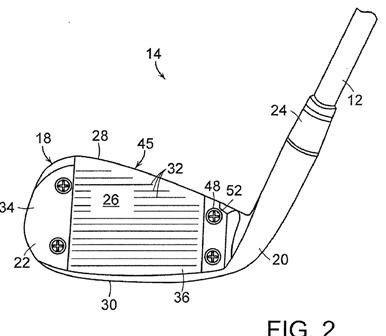
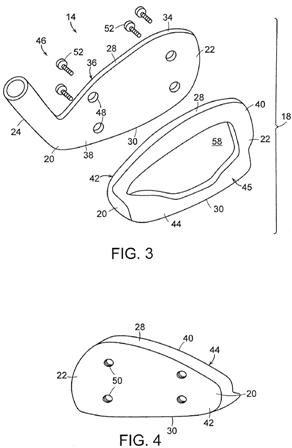
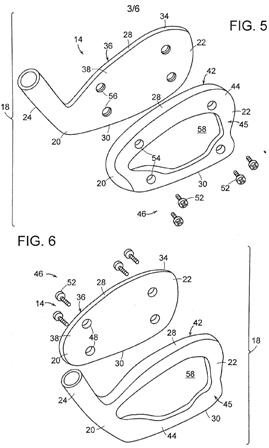
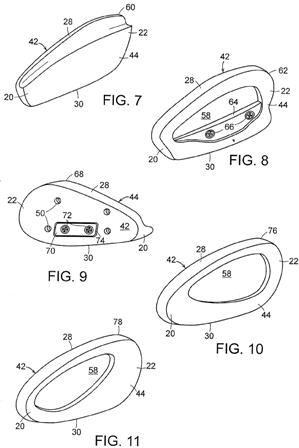
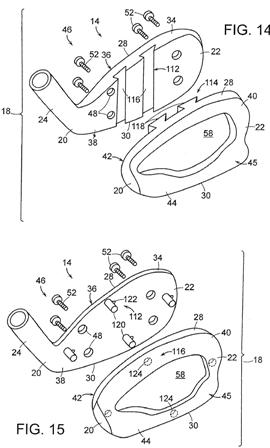
[0034] In the embodiment illustrated in FIGS. 3-4, fastener 46 includes a plurality of apertures 48 extending through first body component 34, a plurality of threaded recesses 50 formed in front surface 42 of second body component 40, and a plurality of threaded fasteners 52. Each threaded fastener 52 is inserted through a corresponding aperture 48 in first body component 34 and threaded into a corresponding threaded recess 50 in second body component 40, thereby firmly securing first and second body components 34, 40 to one another. In this embodiment, as seen in FIG. 2, the heads of fasteners 52 are visible on front surface 36 of first body component 34. Threaded fasteners 52 are illustrated here as screws, but it is to be appreciated that they may be bolts (e.g., bolts with hex key type heads) or any other threaded fastener. If desired, cover or cap elements may be provided so that the fastener heads are not exposed or visible from the front surface 36 of the first body component 34.
[0035] Another embodiment of a fastener 46 used to secure first body component 34 and second body component 40 to one another is illustrated in FIG. 5. In this embodiment, a plurality of apertures 54 extend through second body component, and a plurality of threaded apertures 56 are formed in rear surface 38 of first body component 34. In this embodiment, fasteners 52 are visible on rear surface 44 of second body component 40 and, naturally, rear face 45 of club head 14 when first and second body components 34, 40 are secured with fastener 46. Again, if desired, cover or cap elements may be provided so that the fastener heads are not exposed or visible from the rear surface 44 of the second body component 40.
[0036] Another embodiment of club head 14 is illustrated in FIG. 6, in which hosel 24 extends from heel portion 20 of second body component 40 rather than from first body component 34 as illustrated FIGS. 3 and 5. In certain embodiments, hosel 24 could be formed of two separate pieces (not shown), with each of first body component 34 and second body component 40 including a portion of hosel 24.
[0037] As noted above, because second body component 40 is removably secured to first body component 34, second body component 40 can advantageously, easily, and quickly be replaced with a different second body component having one or more different characteristics than those of the initial second body component 40. Specifically, second body component 40 can be replaced with a new second body component having a different shape or geometry than that of initial second body component 40. Through the use of such interchangeable body components, golf club head 14 can be modified to produce a club head with different performance characteristics.
[0038] As seen in the embodiments illustrated in FIGS. 3 and 5, second body component 40 includes a cavity 58 formed in a central area of rear surface 44 such that club head 14 is what is known as a cavity backed, or perimeter weighted club head. Such a club head distributes the weight of the head around the perimeter of the head, thereby creating a more forgiving golf club head for the golfer.
[0039] An alternative embodiment of a second body component 60 is illustrated in FIG. 7. Second body component 60 has a configuration known as a “blade” or a “muscle back” club, and contrary to that of a cavity back, or perimeter weighted head, does not include a cavity in its rear surface 44. A blade club head concentrates its weight about the center of the club head. Second body component 60 may be secured to first body component 34 in the same manner as discussed above, that is, with a suitable fastener arrangement 46. If desired, a user could convert a perimeter weighted rear body component 40 for a blade type body component 60 on the same front body component 34.
[0040] Another alternative embodiment of a second body component 62 is illustrated in FIG. 8. Second body component 62 is a cavity backed club head, with a cavity 58 formed in its rear surface 44. A weight 64 is secured within cavity 58 with a suitable fastener arrangement 66. As illustrated here, fastener 66 includes a pair of screws extending through apertures in weight 64 and received in threaded recess formed in second body component 62. It is to be appreciated that the performance of club head 14 can also be altered by replacing weight 64 with a different sized weight and/or a weight with a different weight distribution (e.g., a heel biased weight, a toe biased weight, a taller weight, a shorter weight, etc.
Do you think this concept will ever make it to market?
David Dawsey – The Golf Attorney
PS – click HERE to check out other interesting iron designs
